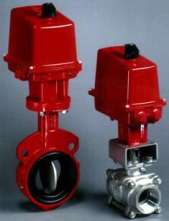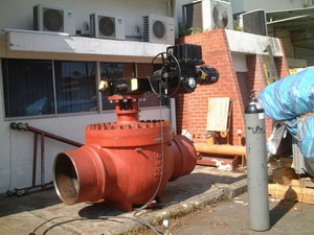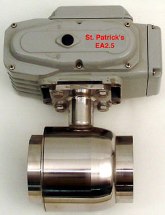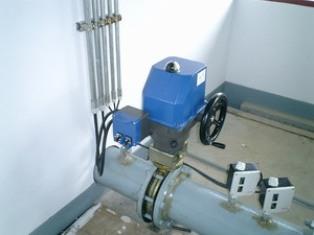Classification of electric drives
 An electric actuator in control systems is commonly referred to as a device designed to move the working body in accordance with signals from the control device.
An electric actuator in control systems is commonly referred to as a device designed to move the working body in accordance with signals from the control device.
Working bodies can be various types of throttle valves, valves, valves, gates, guide vanes and other regulating and closing bodies capable of changing the amount of energy or working substance entering the control object. In this case, the movement of the working bodies can be both translational and rotational within one or several revolutions. Therefore, the drive mechanism, with the help of the working body, directly affects the controlled object.
Actuators are devices that mechanically affect physical processes by converting electrical signals into the required control action. Like sensors, actuators must be properly matched for each application. Actuators can be binary, discrete or analog.The specific type for each task is selected taking into account the required output power and speed.
In general, the electric actuator consists of an electric actuator, a reducer, a feedback unit, an output element position indicator sensor, and limit switches.
 As electric drive in drives electromagnets, or electric motors with a reducer to reduce the speed of movement of the output element to a value that allows direct connection of this element (shaft or rod) with the working body.
As electric drive in drives electromagnets, or electric motors with a reducer to reduce the speed of movement of the output element to a value that allows direct connection of this element (shaft or rod) with the working body.
The feedback nodes are designed to introduce into the control loop an action proportional to the magnitude of the displacement of the output element of the actuator and therefore of the working member articulated with it. With the help of limit switches, the electrical drive of the drive is turned off when the working element reaches its end positions, to avoid possible damage to the mechanical connections, as well as to limit the movement of the working element.
As a rule, the power of the signal generated by the regulating device is insufficient for direct movement of the working element, therefore the actuator can be considered as a power amplifier, in which a weak input signal, amplified many times, is transmitted to the working element.
All electric drives, widely used in various branches of modern technologies for automation of industrial processes, can be divided into two main groups:
1) electromagnetic
2) electric motor.
The first group mainly includes electromagnetic drives designed to control various types of control and shut-off valves, valves, pulleys, etc. actuators with various types of electromagnetic couplings... A characteristic feature of electric actuators of this group is that the force required to rearrange the working body is created by an electromagnet, which is an integral part of the actuator.
For control purposes, solenoid mechanisms are generally used only in on-off systems. In automatic control systems as end elements are often used electromagnetic clutches, which are subdivided into friction clutches and sliding clutches.
The second, currently most common group includes eElectric actuators with electric motors of various types and designs.
 Electric motors usually consist of a motor, a gearbox and a brake (sometimes the latter may not be available). The control signal goes to the motor and the brake simultaneously, the mechanism is released and the motor drives the output element. When the signal disappears, the motor turns off and the brake stops the mechanism. The simplicity of the circuit, the small number of elements involved in the formation of the regulatory action, and the high operational properties have made actuators with controlled motors the basis for creating drives for modern industrial automatic control systems.
Electric motors usually consist of a motor, a gearbox and a brake (sometimes the latter may not be available). The control signal goes to the motor and the brake simultaneously, the mechanism is released and the motor drives the output element. When the signal disappears, the motor turns off and the brake stops the mechanism. The simplicity of the circuit, the small number of elements involved in the formation of the regulatory action, and the high operational properties have made actuators with controlled motors the basis for creating drives for modern industrial automatic control systems.
There are, although not widely used, actuators with uncontrolled motors that contain a mechanical, electrical or hydraulic clutch controlled by an electrical signal.Their characteristic feature is that the engine in them works continuously during the entire time of operation of the control system, and the control signal from the control device is transmitted to the working body through the controlled clutch
 Drives with controlled motors, in turn, can be divided according to the method of construction of the control system of mechanisms with contact and non-contact control.
Drives with controlled motors, in turn, can be divided according to the method of construction of the control system of mechanisms with contact and non-contact control.
The activation, deactivation and reversal of electric motors of contact-controlled drives is carried out using various relay or contact devices. This defines the main distinguishing feature of actuators with contact control: in such mechanisms, the speed of the output element does not depend on the magnitude of the control signal applied to the input of the actuator, and the direction of movement is determined by the sign (or phase) of this signal. Therefore, actuators with contact control are usually called actuators with a constant speed of movement of the working body.
In order to obtain an average variable speed of movement of the output element of the drive with contact control, the pulse mode of operation of its electric motor is widely used.
Most actuators designed for contact controlled circuits use reversible motors. The use of electric motors rotating only in one direction is very limited, but still occurs.
Non-contact electric drives are characterized by increased reliability and allow relatively easy to achieve both constant and variable speed of movement of the output element.Electronic, magnetic or semiconductor amplifiers, as well as their combination, are used for non-contact control of drives. When the control amplifiers operate in relay mode, the speed of movement of the output element of the actuators is constant.
Both contact-controlled and non-contact electric drives can also be divided according to the following characteristics.
By prior agreement: with rotary motion of the output shaft — single-turn; with rotary movement of the output shaft — multi-turn; with incremental movement of the output shaft — straight ahead.
By the nature of the action: positional action; proportional action.
By design: in normal design, in special design (dust-proof, explosion-proof, tropical, marine, etc.).
The output shaft of single-turn drives can rotate within one full revolution. Such mechanisms are characterized by the amount of torque of the output shaft and the time of its complete rotation.
Unlike single-turn multi-turn mechanisms, the output shaft of which can move within several, sometimes a significant number of revolutions, is also characterized by the total number of revolutions of the output shaft.

Linear mechanisms have a translational movement of the output rod and are evaluated by the force on the rod, the value of the full stroke of the rod, the time of its movement in the full stroke section and the speed of movement of the output body in revolutions per minute for single-turn and multi-turn and in millimeters per second for linear mechanisms.
The design of the position drives is such that with their help the working bodies can be set only in certain fixed positions.Most often there are two such positions: "open" and "closed". In the general case, the existence of multi-position mechanisms is also possible. Position drives usually do not have devices to receive a position feedback signal.
Proportional actuators are structurally such that they ensure, within the specified limits, the installation of the working body in any intermediate position, depending on the magnitude and duration of the control signal. Such actuators can be used in both positional and P, PI and PID automatic control systems.
The existence of electric drives of both normal and special design greatly expands the possible areas of their practical application.
